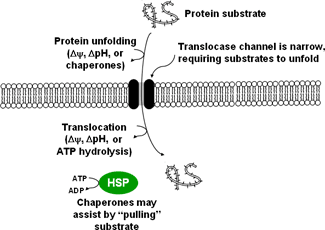
Protein Translocation Across Membranes

Fig 1. Transmembrane protein translocation.
Translocase channels (TCs) are ubiquitous structures that transport proteins across membranes (Fig. 1). TCs are critical to protein secretion, to how integral membrane proteins properly fold and insert into membranes, to organelle biosynthesis, and to microbial pathogenesis. The translocon transports soluble proteins into the endoplasmic reticulum's (ER) lumen and mediates the co-translational synthesis of integral membrane proteins. Inner- and outer-membrane TCs allow cytosolic proteins to enter mitochondria and chloroplasts. TCs integral to microbial pathogenesis include autotransporters, numerous secretion apparati as well as the toxins that cause anthrax, diphtheria and botulism. These toxin components assemble on host cell surfaces, undergo endocytosis, and form TCs that allow separate proteins or domains to cross the endosomal membrane into the cytosol. [top]

Fig 2. Chemical complexity of a TC's protein substrate.
How do TCs mediate protein unfolding and translocation? As many TCs have narrow pores, substrate proteins must shed their tertiary structure. This energetically costly process requires either a transmembrane gradient for a driving force or an ATP-dependent chaperone activity to facilitate unfolding. The now unfolded protein presents a new series of challenges to the translocase channel; i.e., a chemically complex, highly flexible polymer chain must be directed through the narrow channel to the other side of the membrane. This polymer translocation problem adds an entirely new dimension to the current excitement surrounding structure/function studies of ion channels. Unlike the K+ channel, which specifically selects for its substrate—the K+ ion—by mimicking its first hydration shell, such specificity is unlikely in a TC, because its substrate—unfolded protein—is vastly more complex, presenting a flexible polymer chain composed of positive, negative, hydrophilic and hydrophobic groups (Fig 2). Therefore, many types of interactions are expected within a narrow TC. This interdisciplinary research problem impacts many areas, including in vivo protein unfolding mechanics, ion channel permeation, channel gating, toxin biology, polymer dynamics, and general translocation mechanisms, like Brownian-ratchets. [top]
To address these questions our lab is investigating translocase channels central to microbial pathogenesis. Protein translocation is critical to many host-pathogen interactions. Bacteria utilize translocase channels to either secrete toxins and virulence factors or display adhesin molecules on their outermost membranes; and by means of these secreted molecules, the pathogen can successfully attach to, disrupt, and/or invade its host's cells. Anthrax toxin, for example, has proved to be a promising model system to study protein translocation. The toxin is composed of a TC, called protective antigen (PA), which allows its two substrate proteins, lethal and edema factors (LF and EF), to translocate across a host cell's endosomal membrane and enter the cytosol. Once in the cytosol these factors catalyze enzymatic reactions that disrupt the host cell.
To study protein translocation, the lab makes use of quantitative biophysical methodology and structural biology techniques. We use various spectroscopies to determine the fold stability of substrate proteins and observe relevant conformational changes. To monitor how these substrate proteins translocate through TCs, we use electrophysiology methods. To observe structural consequences of oligomeric assembly and translocation, we employ electron microscopy (EM) and X-ray crystallography. General protein engineering techniques, molecular biology, protein chemistry and synthetic chemistry are all staple methodologies in the lab. We maintain a continued interest in building new apparatus to study these phenomena in greater detail. [top]